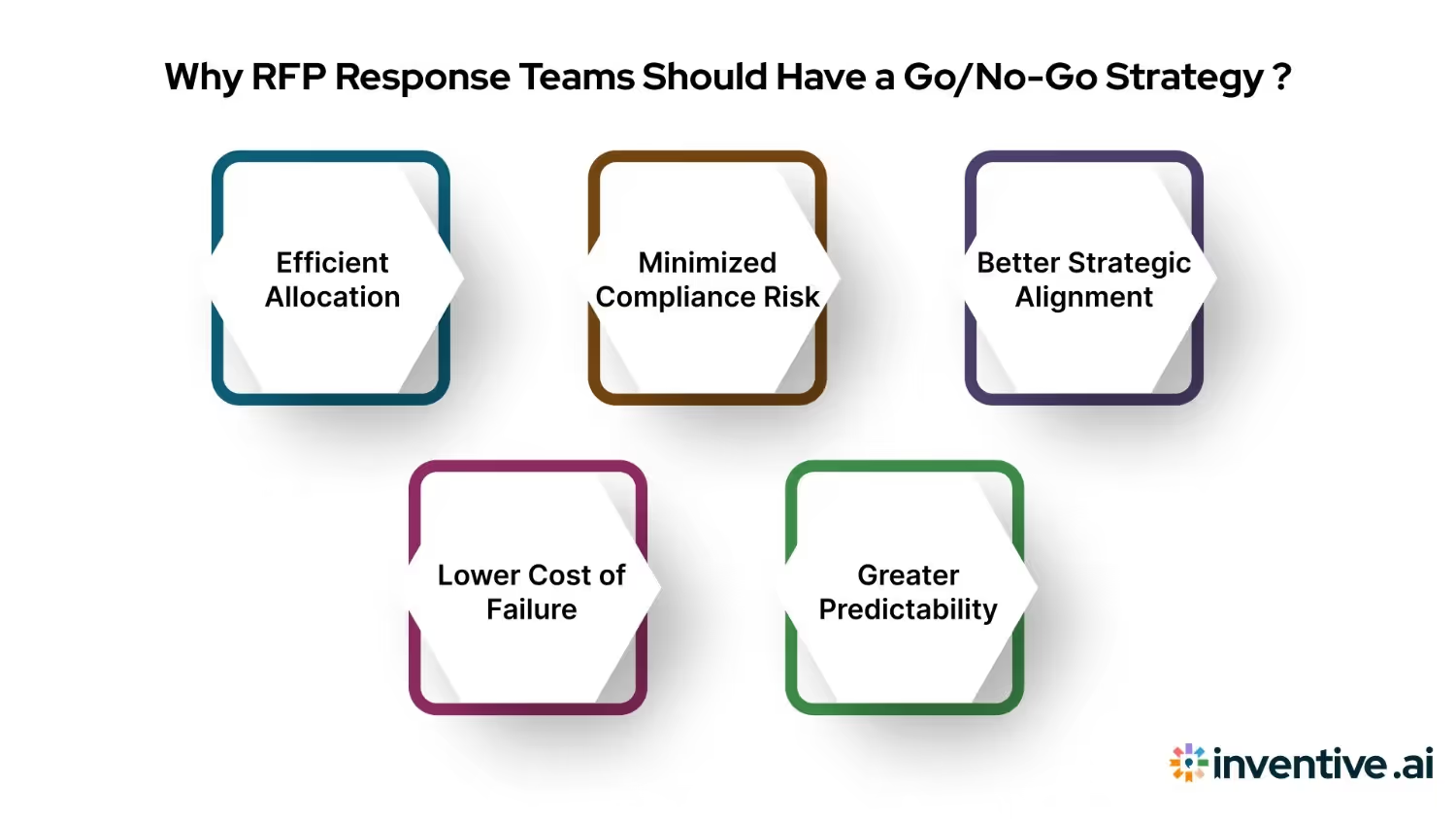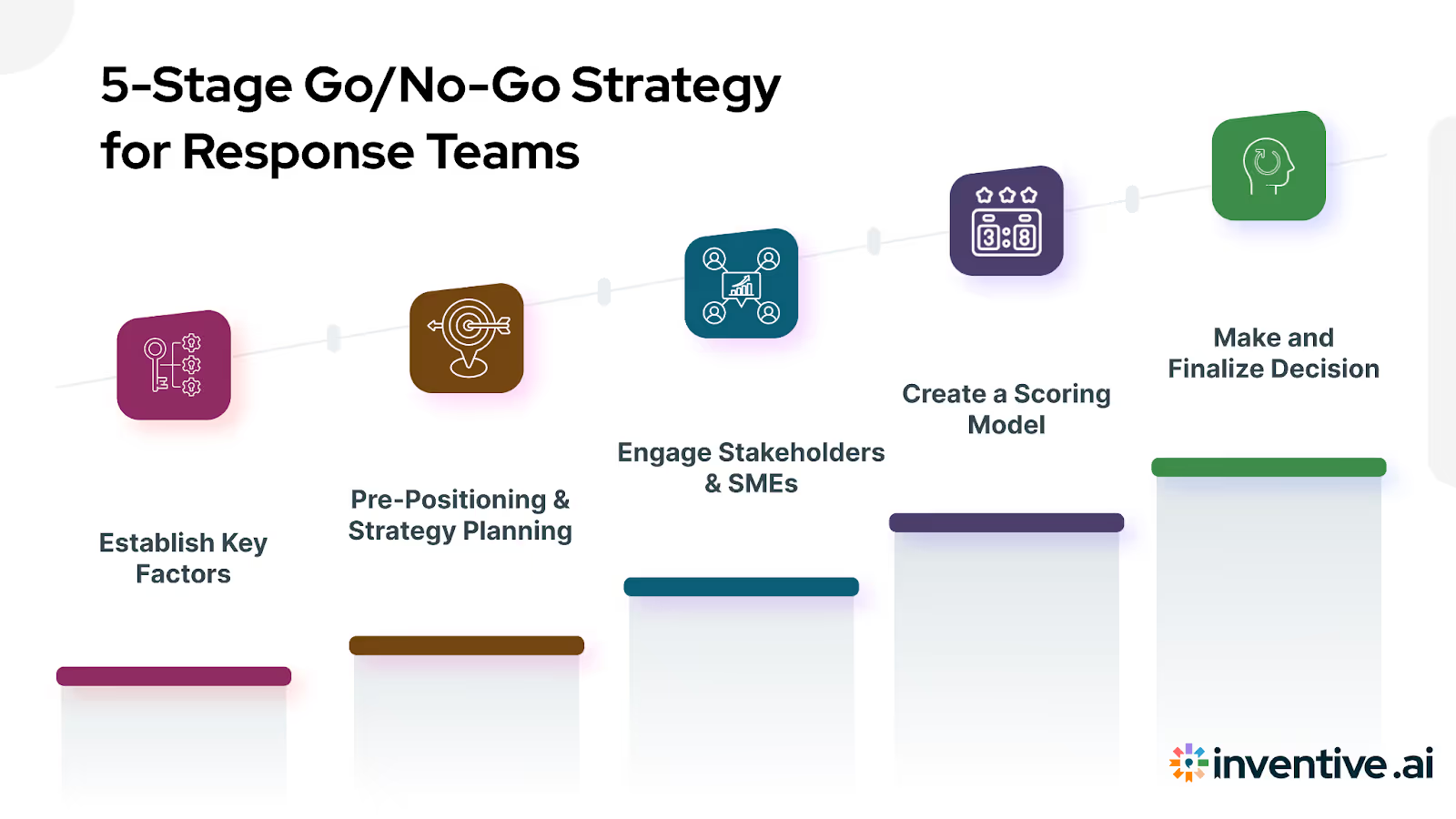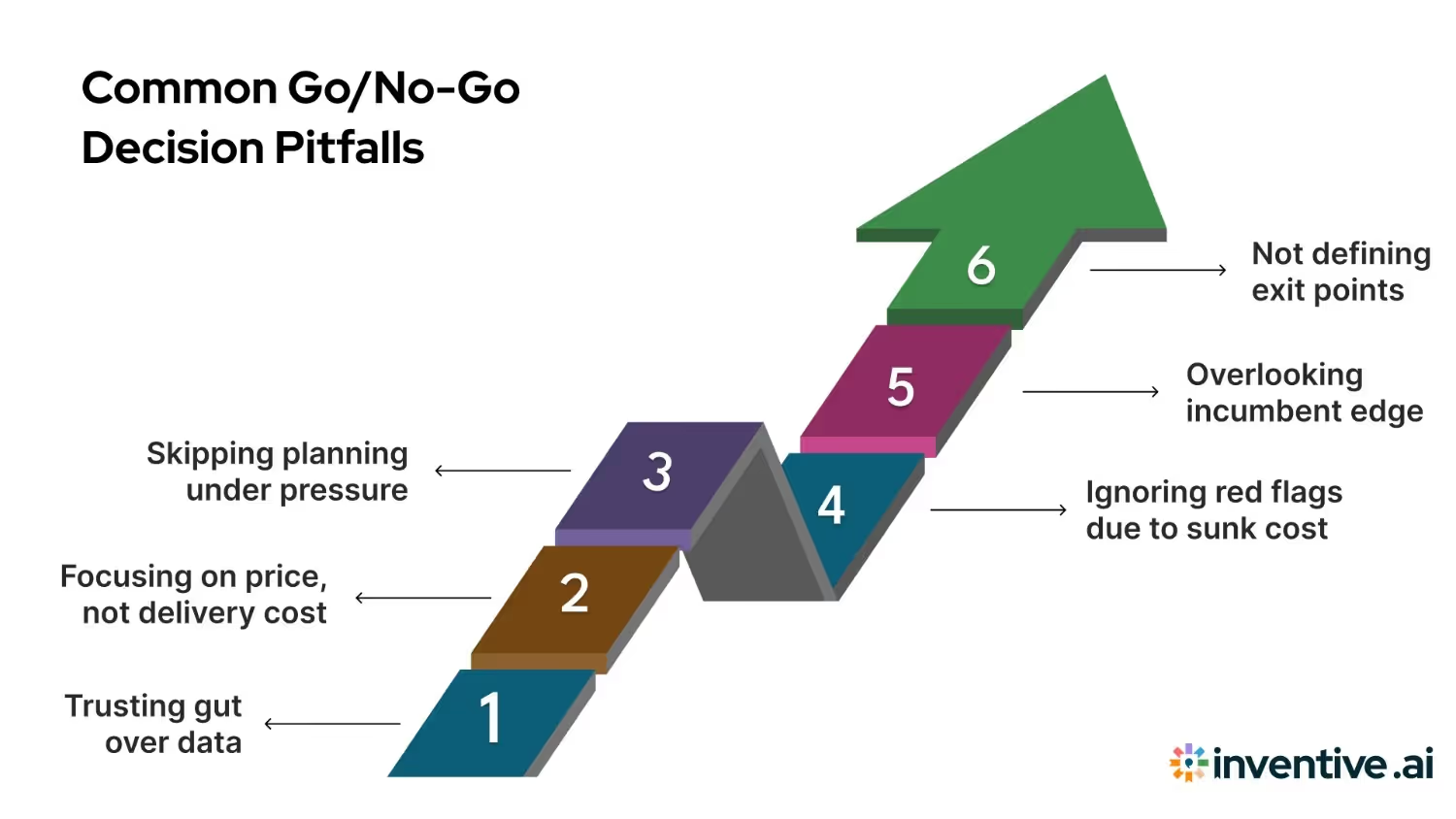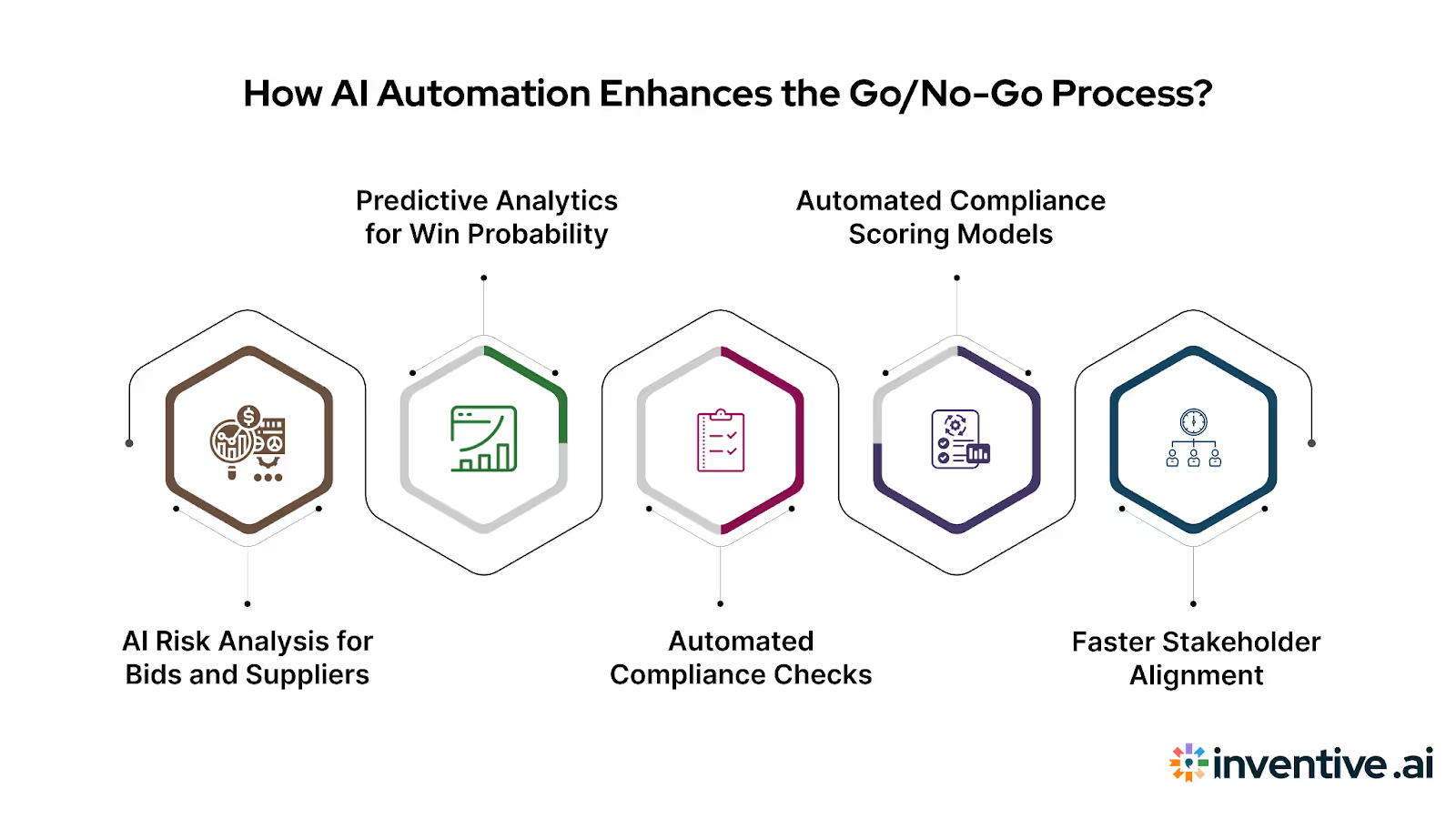Go/No-Go Decision Process: Steps & Checklist for Projects
Learn the Go/No-Go decision process with 5 expert steps, key mistakes to avoid, and a free checklist to streamline your RFP strategy.

When was the last time you sat with your team, staring at an RFP and wondering: is this worth our time or a dead end? That single decision can drain hours and stall momentum.
McKinsey research reveals that executives spend nearly 40% of their time making decisions, and most believe that time is poorly used. In responding to an RFP, the wrong decision isn’t just wasted effort; it can mean burning resources on a bid you’ll never win or realizing halfway through that the project isn’t viable.
Choosing which opportunities to pursue is as critical as winning them. Every RFP response demands time, expertise, and budget—none of which you can afford to gamble. That’s where a Go/No-Go framework changes the game. Using data-driven criteria helps you qualify projects quickly and accurately, reducing wasted effort on low-value bids and focusing resources on high-win opportunities.
Key Takeaways
- Saying “No” can be strategic. Walking away from the wrong RFP protects resources and keeps you focused on growth-ready projects.
- Our guide helps you build a clear, repeatable Go/No-Go strategy for bidding with 5 easy steps.
- Discover the common mistakes that can derail the process and learn how to prevent them early.
- Use our checklist. Download 20+ critical questions to evaluate bid worthiness with confidence.
- See how AI speeds up Go/No-Go calls and improves win probabilities.
What is the Go/No Go Strategy?
A go/no go decision is a structured evaluation process that determines whether your organization should pursue a project or decline it. In the RFP response process, the Go/No-Go decision helps vendors determine whether to pursue a bid or walk away based on strategic fit, margins, and likelihood of winning.
The process takes the front seat because every decision shapes resource allocation, compliance, and profitability.
It might feel counterintuitive, but sometimes the smartest move is walking away from a deal. Saying no can free your team to focus on high-value projects that actually drive growth and protect profitability.
A structured go or no go decision framework evaluates opportunities against financial viability, regulatory standards, and strategic alignment. For CFOs and bidding heads, this is the difference between controlled growth and uncontrolled risk exposure.
Why RFP Response Teams Need a Go/No-Go Strategy

A structured Go/No Go process delivers measurable advantages for response teams and leadership. Instead of reacting to every opportunity, you make deliberate choices that protect profitability and compliance. Here are the core benefits:
- Smarter Resource Allocation: Focus your team’s time and budget on bids with the highest potential for success, rather than chasing low-value opportunities.
- Reduced Compliance Risk: Validate every project against regulatory and contractual requirements before committing to it.
- Better Strategic Alignment: Prioritize opportunities that directly support revenue targets and long-term organizational goals.
- Lower Cost of Failure: Prevent wasted effort, missed deadlines, and margin erosion by eliminating unqualified or unprofitable projects early.
- Greater Predictability: Establish a clear governance framework that enables you to forecast outcomes with confidence.
When these benefits compound, your response function becomes proactive rather than reactive, delivering a higher ROI and better governance at scale.
5 Step-by-Step Go/No Go Strategy for Response Teams

If you want your Go/No Go process to work, it needs structure and an execution plan. Here’s how to build a framework that scales, reduces risk, and focuses effort on the right opportunities. Follow these steps in sequence; each one sets the stage for the next.
Step 1: Set Strategic Determining Factors
Before you invest hours in analysis, eliminate opportunities that don’t fit your business fundamentals. This step acts as your first filter, saving time and resources by rejecting projects that are out of scope, non-compliant, or unprofitable.
What to Check
- Project Type: Does the project fall within your area of expertise? If it’s outside your capability (e.g., requiring specialized construction or marketing services you don’t offer), it’s an immediate No-Go.
- Project Life Cycle: Can you complete the project within the required timeline? If the delivery schedule is unrealistic for your team’s capacity, that’s a red flag.
- Financial Thresholds: Will the opportunity deliver acceptable profit margins after factoring in pursuit costs?
- Compliance Requirements: Does the project meet all mandatory regulations and internal governance standards?
Pro Tip: Build a “No-Go Triggers” list (e.g., history of delayed payments, unrealistic timelines).
For example, suppose you’re responding to a marketing RFP, and the client’s scope requires capabilities you don’t offer, say, influencer management, when your core strength is paid media. In that case, this is an immediate red flag.
Outcome: You eliminate low-fit opportunities early, freeing your team to focus on high-probability wins.
Step 2: Pre-Positioning and Capture Planning
Once an opportunity passes your initial filter, the next move is intelligence gathering. This stage is about positioning your firm to win before you even start writing the response. A well-executed capture plan helps you understand client priorities, competitive threats, and internal decision dynamics.
Understand the Client’s Procurement Workflow
Start by decoding how the client evaluates proposals. Do they use weighted scoring? Is cost more important than technical merit? Knowing this helps you align your proposal narrative with the evaluation framework.
Example: If a government agency uses a 60-30-10 scoring split for technical, cost, and compliance, you know technical superiority will carry the most weight in your bid.
Map the Decision-Makers for Go/No-Go Evaluation
Before you commit resources, assess whether you have strong positioning with the key stakeholders. If you don’t know the influencers or lack a champion inside the client organization, your win probability drops significantly, and that should impact your Go/No-Go call.
Example: If you’re evaluating a construction RFP and you discover the incumbent vendor has strong ties with the technical evaluator (influencer) and the CFO (approver), but you have no champion in the organization, your Go/No-Go strategy should lean toward No-Go unless you can change this dynamic quickly.
Estimate Win Probability
Leverage past bid data to assess your odds. If similar projects in this sector had a low success rate for you, factor that into the decision before you allocate resources.
Outcome: You move into the decision-making stage with clear visibility of stakeholder priorities, evaluation criteria, and competitive dynamics, giving your team a data-backed advantage.
Step 3: Engage Stakeholders and SMEs for a Quick Validation
A Go/No-Go decision is not a solo call. Bringing the right voices into the room ensures your decision is grounded in reality. The benefit? You avoid sinking time into bids that your team can’t deliver or doesn’t believe in.
Keep the group lean, with a maximum of 5–7 stakeholders to maintain speed and accountability.
Who to Involve
- Finance Lead: Can the budget and margin work?
- Delivery Manager: Do we have the resources and timeline flexibility?
- Compliance or Legal: Any red flags that could block us later?
- Subject Experts (if needed): Only for areas where you need clarity fast.
What to Do if Issues Come Up
- Tight Timeline? Explore phased delivery or partial bidding options.
- Resource Gap? Check if contractors or partners can fill the gap.
- Compliance Concern? Negotiate terms early or propose acceptable alternatives.
How to Structure Input
Keep the discussion focused by using a predefined questionnaire instead of open-ended opinions. Ask specific, measurable questions like: Do we have the resources to execute this project? What’s the cost of pursuing it compared to the expected gain?
This approach eliminates guesswork and ensures decisions are based on facts, not assumptions.
Outcome: You walk away with a clear view of risks and potential fixes, so you only move forward when there’s a workable path.
Step 4: Build a Weighted Scoring Model & Compliance Matrix
This is where you replace intuition with math. A scoring framework ensures objectivity and consistency across decisions.
Key Factors to Score
- ROI and Financial Impact – 30% weight.
- Compliance and Regulatory Fit – 20% weight.
- Strategic Alignment – 20% weight.
- Resource Capacity – 15% weight.
- Risk Exposure – 15% weight.
Example: If a project scores 82% but has a compliance gap, the decision could be “Go” with a mitigation plan rather than “No-Go.”
Outcome: You now have a quantified, defensible basis for your Go/No Go decision.
Step 5: Make the Decision and Lock It In
After you’ve gathered insights and explored fixes for any issues, it’s time to make the call, Go or No-Go. The purpose here is to move forward confidently, without second-guessing later.
How to Decide?
- If the project aligns with your strategic goals, budget, and resource capacity, and risks have workable mitigations, → Go.
- If major gaps remain in compliance, margins, or delivery capability → No-Go.
- If certain conditions could make it viable later (e.g., extra budget approval) → mark as “Not Yet” and revisit when those conditions change.
Pro Tip: Document the reasoning behind your decision. This creates a knowledge base for future evaluations, helping you refine your response process and avoid repeating mistakes.
When you’ve worked through every step and checked the critical boxes, you’ll know if the project deserves a green light. At every stage, challenge your team with one question: Can we deliver this successfully under the current conditions?
If the answer is yes, move forward with confidence. If not, hit pause, reassess your options, and proceed only when the risks are truly manageable.
6 Common Pitfalls in Go/No-Go Decisions (and How to Avoid Them)

Even experienced response teams fall into patterns that drain resources and lower win rates. Here’s how to stay ahead:
- Making decisions on gut feeling rather than hard data: Without structured scoring or historical insights, teams overestimate win probability. Use a weighted scoring framework tied to win-loss history to make every decision evidence-based rather than instinctive.
- Looking only at bid price instead of the full cost to deliver: Projects that seem profitable upfront often collapse under compliance costs and delivery risks. Always calculate the full lifecycle cost, including internal effort, compliance overhead, and margin pressure, before green-lighting.
- Skipping pre-positioning and capture planning under time pressure: Rushing into a bid without mapping influencers or validating budget certainty leaves you at a disadvantage. Even under tight deadlines, run a short capture session to identify key decision-makers, blockers, and success criteria.
- Ignoring early red flags because of sunk cost bias: Teams keep pushing proposals forward after uncovering fatal flaws. Establish disqualification triggers, such as missing certifications or lack of financial clearance, and act on them immediately, no matter how much work is already done.
- Overlooking the incumbent advantage: Chasing bids where the incumbent has a strong hold often results in wasted effort. Before investing, confirm if you have an internal champion and clarity on how to differentiate beyond pricing.
- Failing to define exit points: Without predefined stop conditions, teams waste weeks debating low-odds projects. Create early exit gates based on non-negotiable criteria like compliance requirements, budget thresholds, or scoring benchmarks.
Also Read: RFP Response Best Practices: Proven Steps and Tips to Win More
10 Questions to Add to Your Go/No-Go Checklist
Before committing resources to an RFP response, make sure you have a structured decision framework. Here are ten essential questions every response team should ask:
- Does this opportunity align with our business strategy and growth priorities?
- Do we have the technical expertise and past performance to compete effectively?
- Is the client’s budget confirmed and aligned with our pricing structure?
- Are we the incumbent vendor? If not, is there an incumbent, and how strong is their position?
- If there is an incumbent, is the customer satisfied with their performance?
- Do we have a strong relationship with the client or an internal advocate?
- Does the RFP appear to favor a competitor based on language or technical specifications?
- Will winning this project require significant new investment (staff, technology, process)?
- Can the work be delivered within the client’s required timeline without resource strain?
- Would this project strengthen our market positioning or create new case study opportunities?
How AI Automation Enhances the Go/No-Go Process

Manual Go/No-Go evaluations often feel like detective work—chasing down scattered data, debating assumptions in endless meetings, and relying on gut instinct instead of evidence. This approach creates risk: you may chase low-probability bids, waste resources, or miss lucrative opportunities simply because the signals weren’t clear early on.
AI-powered automation eliminates these inefficiencies by bringing speed, precision, and data-driven insight to every stage of the Go/No-Go decision process. Here’s how it transforms response strategy:
1. AI-Powered Risk Analysis for Bids and Suppliers
When risk evaluation depends on spreadsheets and scattered emails, critical factors slip through the cracks, like supplier stability or contract penalties. Automated risk engines pull data from compliance records, financial reports, and market intel to flag high-risk bids in real time.
2. Predictive Analytics for Win Probability
Manual scoring systems rely heavily on judgment calls. That’s why teams sometimes chase RFPs they were never going to win.
Predictive models analyze historical win/loss data, competitor behavior, and client preferences to calculate success probability before you commit resources.
3. Automated Compliance Checks
Compliance gaps are one of the most expensive late-stage failures in bids. Manually cross-checking certifications and requirements is slow and error-prone.
AI instantly scans RFP requirements against your company’s certifications, experience, and past responses.
4. Automated Compliance Matrix and Scoring Models
AI can generate a compliance matrix by cross-referencing RFP requirements against your company’s certifications and past responses. You can also build a weighted scoring model, prioritizing financial viability, strategic fit, and risk factors with minimal manual setup.
5. Faster Stakeholder Alignment
Conventional Go/No-Go reviews often become bottlenecks, resulting in excessive emails, meetings, and version control issues that slow everything down.
Automated workflows consolidate scoring, risk flags, and opportunity summaries in a single dashboard. Decision-makers can review, comment, and sign off in minutes instead of days.
Why This Matters for Response Leaders
Every late “No-Go” decision drains resources that could have been spent on high-probability bids. Automation gives you clarity at the right time: before your team invests hours in a losing game.
Inventive AI takes these benefits further by centralizing all past bids, compliance data, and Q&A into a single Knowledge Hub for quick reference, while its AI-powered win theme engine identifies gaps in your proposal strategy and fills them with content drawn from trusted sources.
Conclusion
A structured Go/No-Go strategy ensures your team only pursues bids that align with your resources, expertise, and growth goals. It’s the difference between chasing every opportunity and focusing on the ones you can actually win, but even after the decision is made, speed and accuracy matter. Delays in drafting or compliance checks can cost you the advantage you just secured.
Inventive AI’s AI RFP Agent eliminates the bottleneck after the “Go.” It generates 95% accurate first drafts in minutes, pulls only from your verified knowledge base, and applies tone and compliance rules automatically.
What Our Clients Say
"Inventive has completely streamlined my RFP process. We're now 90% faster, and our win rate has increased by 50%."
— Shikha Chauhan, Product Manager at Hexalog
"Overall, my RFP workflow is SO much faster now with Inventive. My day was a lot less stressful using Inventive."
— Anthony Pukal, Solutions Consultant, Insider
Request a Demo Today and Turn Your Go Decisions into Faster Wins.
FAQs About the Go/No-Go Decision Process
Still having doubts about your decision process, below we answer a few common questions.
1. What is a Go/No-Go decision in RFP response?
It’s a structured decision-making process used to determine whether your organization should pursue a bid or opportunity. It ensures that only strategically aligned, profitable projects move forward.
2. When should a Go/No-Go decision be made?
The decision should be made before investing significant resources in proposal development, typically right after opportunity assessment and before detailed capture planning.
3. What factors should be considered in a Go/No-Go evaluation?
Typical factors include:
- Alignment with business strategy
- Profitability and pricing feasibility
- Resource availability
- Competitive positioning and incumbent strength
- Compliance with mandatory requirements
4. Can AI really make the Go/No-Go process more effective?
Yes. AI-driven tools can analyze historical performance, predict win probability, flag compliance issues, and suggest win themes—making the decision faster, data-driven, and less subjective.
5. How can we avoid mistakes in the Go/No-Go process?
Avoid bidding on every opportunity, skipping a structured checklist, or underestimating risks. Use predefined criteria, scoring templates, and collaborative input to make objective decisions.


